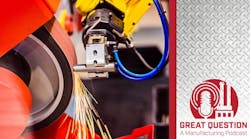Podcast: How to choose the right grinding system for your foundry
Jeffrey Antonic is managing director of Stratecasts LLC. He has over 42 years of international plant operations, foundry/forge, and machining experience. Throughout his career, Jeffrey has worked for Daimler-Chrysler Corporation, Brunswick Corporation-Mercury Marine, Allis Chalmers Foundry and Motor Castings Foundries. He also authored an article titled, “Robotic Grinding vs. CNC Grinding,” which details how to determine the best automated or semi-automated solution for your foundry. Jeffrey recently spoke with Robert Brooks, editor in chief of American Machinist and Foundry Management & Technology, about grinding systems for cast parts.
Below is an excerpt from the podcast:
F: Would you first start by telling us what Stratecasts is and does?
JA: Yes. I'll be very brief. Many people have remembered the name from its founding father, Ken Kirgin. For many years, we published in many magazines the annual forecast and trends for the metal casting industry, and it’s much different than normal crawlers or public data. We do it by alloy, by process, by platform. By foundrymen for foundrymen. And that's the differentiator. So, we do a lot of international tracking analysis, types of platforms, effects of things like electric vehicles on our platforms, etc. The second part of the company, which we thought we never would revisit again, but by golly, we are. In the day, everyone remembers the two biggest foundry engineering firms in the world that are no longer in existence. One was Lester B Knight in Chicago, and the other was Giffels out of Detroit, each commanding about 200 engineers doing the big plants. And the gentleman that ran that was Ken Kirgin, who then founded Stratecasts.
We're not selling machinery. We're selling a neutral perspective by foundrymen in the area of casting and new technology. Many times, what we're seeing is that the foundries of today are being supplier driven. They're not getting the real options that they need to hear about before making this huge decision to go forth. So, the other part of Stratecasts is in bringing forth new technology like this, solving solutions and then turning them into projects as needed. But our focus today is about the new technologies that are available and how to make the decisions in terms of grinding.
F: Well, you make a couple of good points there. I don't think it's just foundries. I think a lot of small and medium manufacturers have had to outsource their engineering. And that puts them at a little bit of a disadvantage. I don’t think that's the discussion today, but in any case, there does need to be an infusion of expertise in a lot of these businesses. One thing that occurs to me on this particular subject is that grinding technologies generally falls outside the stated scope of metal casting. They understand metallurgy very well. They understand material technology and forming technology very well. But now we're getting into the next stage, which is how to make those cast parts presentable. Do you find that to be true?
JA: Absolutely. It's a completely different paradigm. It has different EPA requirements, safety requirements, etc. And many times, it's taking up Class A plant space which could be used for production and other things.
F: And just to state the obvious, it's also an issue that intersects immediately or head on crashes with the problem that everyone has with labor. This is a very labor-intensive activity, and you listed not only the EPA issues, but also the OSHA issues involved, so there are those factors as well. And I think that's how a lot of metal casters have come to the idea of selecting their grinding capabilities, their grinding technologies. But let's talk about the contrast that you present. You present this contrast between robotic grinding systems and CNC grinding systems. Does that choice more or less hinge on the volume of production that needs to be done?
JA: Volume and topology of the parts and alloy, because it's not all things. Consider, for example, if we're grinding bronze castings or aluminum. It’s completely different than gray and high-chrome steels. So, you have to have a lot of inherent process knowledge, knowledge of abrasives, speeds, feeds, etc. And let me just go back a little bit and set the platform as to how we got into this and why.
